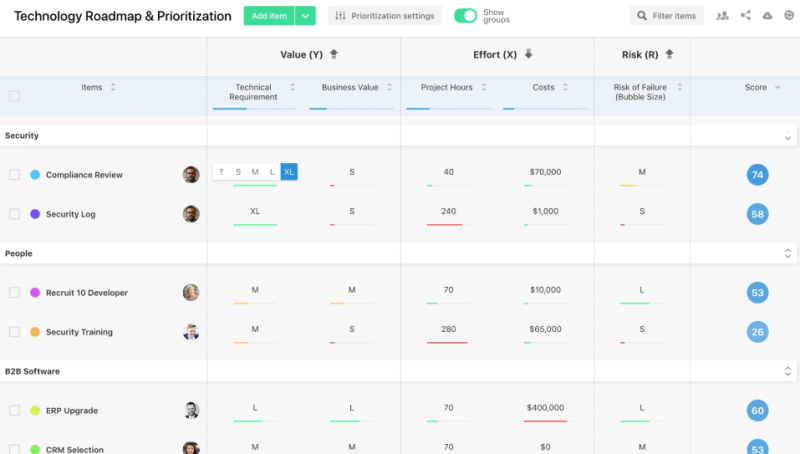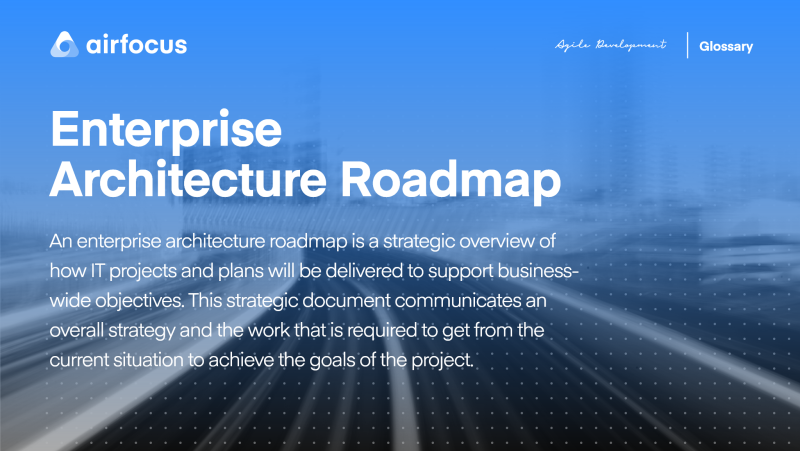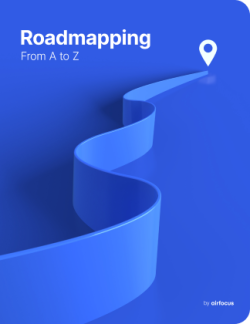Enterprise Architecture Roadmap
What is an enterprise architecture roadmap?
Definition of an enterprise architecture roadmap
An enterprise architecture roadmap is a strategic overview of how IT projects and plans will be delivered to support business-wide objectives. This strategic document communicates an overall strategy and the work that is required to get from the current situation to achieve the goals of the project.
This roadmap works towards achieving an enterprise architecture vision, which is defined by an enterprise architecture planning (EAP) process.
These roadmaps are used for a wide range of initiatives and projects, including:
Digital transformation - Taking an offline process and moving it to an online process
Change management - Planning how to support your team in transitioning to a new tool or process
Legal changes - Modifying IT processes to comply with new regulations and standards, such as GDPR and ISO standards.
Advantages of using an enterprise architecture roadmap
For those involved in enterprise architecture, including dedicated enterprise architects, management, and IT professionals, a good enterprise architecture roadmap is a must-have.
It helps to keep projects and plans on track
Digital overhauls can be highly complex processes, which means it’s essential to have a strategic blueprint that clearly defines how a company is going to get from A-B. Having a strategic roadmap means your team has a point of reference, so they can make immediate adjustments to stay on track when things go wrong. It is also easier to stop blockers before they impact the project.
It keeps stakeholders aligned
An enterprise architecture roadmap is an effective tool for gaining stakeholder support for a project for two key reasons.
Firstly, a roadmap clearly shows what the result of the project will be and what benefits will be gained by the business. This helps earn the support for executives, investors, management and key stakeholders who want to know precisely how your project will improve the performance of the business.
Secondly, a roadmap helps those who are working on the project understand how tactical details relate to the strategic big picture. With this knowledge, teams are motivated to work through difficult challenges to achieve the vision of the project.
By creating a roadmap, complex IT initiatives can be understood visually by all stakeholders, making communication and gaining alignment easier.

What are some common challenges with creating an enterprise architecture roadmap?
When creating an enterprise architecture roadmap, there are several common pitfalls to avoid.
There are too many strategic items
When planning enterprise architecture, it's easy to want to fix all the things at once by introducing new processes, technologies and strategic initiatives simultaneously. However, the best roadmaps focus on making the largest possible improvement with the smallest amount of effort, picking just a few key issues to address. This keeps your roadmap focused and increases the chances of success.
It’s not measurable
If the goals of your project are not easily measurable, it will be very difficult to judge the success. The best enterprise architecture roadmaps include key performance indicators. This enables you to measure progress accurately and check you are achieving the key goals of the project.
It’s not expert-led
When creating an enterprise architecture roadmap, you must make assumptions about how the organization currently works. This can only be accurate by including subject matter experts from every department in the organization. They should also be involved in the prioritization and sequencing on tasks, as only they have an on-the-ground view of the cost-benefit of actions.
How to build an enterprise architecture roadmap with airfocus
At airfocus, we have a range of templates available for creating great roadmaps quickly. For an enterprise architecture project, our technology roadmap and prioritization template is a perfect fit, with modifiable prioritization scoring based on impact, cost and risks.

Before you jump into your enterprise architecture roadmap, there are a series of best practices to follow.
#1. Develop a clear understanding of the organization right now
You can't plan a direction for the future without understanding the current state of your organization. Be sure you can measure critical business objectives, fully understand operational costs and know what your key technical assets are at the current time.
#2. Know your goal
You need to know what you are working towards by involving key stakeholders across the organization. Next, quantify these goals - good examples include revenue targets and measurable efficiency improvements, such as reductions in cost, wasted time or wasted labor.
#3. Define the gap between the current state and the goal state
To define the gap, there are 2 critical questions to answer.
Firstly, what is the difference between the current state of the organization and the goal state (remember, there’s like to be no end to your roadmap, but rather milestones to work toward and then add to)? This should be a quantitative measurement across one or more key performance indicators. For example, a 20% improvement in revenue from a 40% reduction in churn.
Secondly, what are we doing incorrectly and where? Consider the whole business in this assessment, not just in technical areas. For example, churn could be reduced with email automation, improving customer service and hiring dedicated account managers.
#4. Prioritize and sequence
From the last step, we have a list of items that need to be addressed. Next, these must be prioritized and sequenced, so we can focus on the items with the highest business value.
Then, identify any dependencies to determine the sequence. These could be technical, organizational or people factors - for example, how quickly will employees adapt to the changes you are making?
With our prioritization wizard, you can define your key costs and benefits and score them by completing a simple wizard. Our algorithms calculate your priorities in seconds.
#5. Draft and publish the roadmap
The final step is to speak to stakeholders and subject matter experts about your roadmap. With roadmap tools like airfocus, you can easily share the roadmap and make refinements as required.
What should an enterprise architecture roadmap include?
While each EA roadmap will be unique, they should all have a few key bits of data.
These bits of data help structure the EA roadmap and ensure that all relevant info is there for your team to follow.
Business capability maps
For those that don't know, a business capability map is a chart that provides an idea of your business's current capabilities.
It's also common for a business capability map to include an idea of where your capability needs to be. This will help you understand where you stand and help you develop your business's skills to a point where you can accomplish your EA roadmap.
Application portfolio data
Including your application portfolio in your EA roadmap can also be important. Application portfolio data is information on the apps and services your business currently uses to accomplish various tasks.
Similar to a business capability map, you can use an application portfolio to determine how you’ll reach your enterprise architecture roadmap goals.
Input from all relevant stakeholders
This includes getting input from any involved teams, higher-ups, investors, and managers.
These are the individuals who will be impacted by your enterprise architecture roadmap and who will have the best understanding of your capabilities and goals.
KPIs
Including KPIs in your EA roadmap can be a great way to ensure that you can reach your goals sustainably. KPIs, or Key Performance Indicators, are data points used to measure your company's performance.
You can use KPIs in your enterprise architecture roadmap to track your progress, understand what resources are currently available, and achieve your goals without putting too much strain on your company.
Enterprise architecture roadmap example styles
Now that you know what to include in your EA roadmap let's look at specific enterprise architecture roadmap example styles that your roadmap can follow.
Transformation maps
These are a bit like a classic mind map, helping you organize your goals and ideas by the connections and relationships between these ideas and goals.
Gantt charts
Gantt charts are useful when you want to break down your enterprise architecture roadmap example by the tasks within it. It allows you to structure what needs to be done and to view it in a task-oriented way.
Workflow charts
Workflow charts are useful in creating an enterprise architecture roadmap example when you want to factor in the workflows that your teams and your business use.
You may want to do this when your EA roadmap is particularly task-oriented because workflow charts can help you understand exactly how you aim to achieve your goals and which departments will help you achieve them.

General FAQ

Glossary categories
Build great roadmaps

Experience the new way of doing product management








